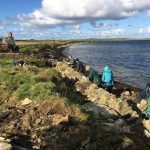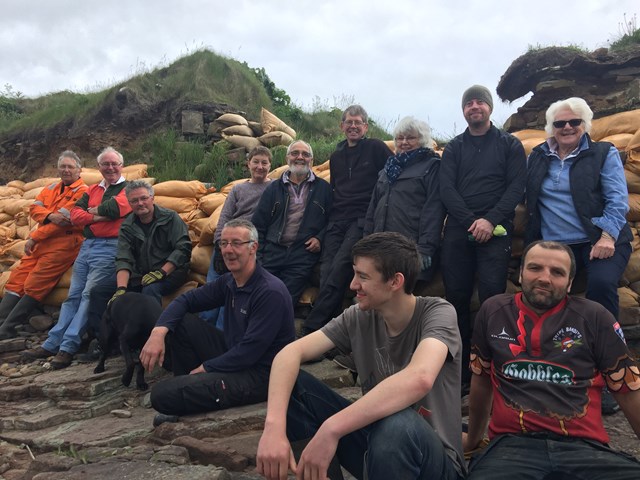

Historic Environment Scotland funding for Orkney projects

(Jonathan Ford – Papay Ranger)
PROJECTS to engage the local community in coastal protection in Papay Westray, and collate archive material about Newark Bay cemetery and chapel in Deerness are set to benefit from funding as part of Scotland’s Year of Coast and Waters.
In total Historic Environment Scotland (HES) has announced funding of £194,349 to 18 community-based projects to protect, promote or engage with Scotland’s coastal or waterway heritage as part of its Coast and Waters Heritage Fund.
Grants of £3,000 to £20,000 have been awarded to projects which deliver benefits to the local community through outreach and educational activities, repairs to stabilise historic or marine structures, developing traditional skills and increasing understanding of Scotland’s coasts and waters heritage.
Funding has also been awarded to projects which are developing and implementing measures to enhance resilience and adapt to climate change.
The Orkney recipients are Papay Development Trust which has been awarded £7,950. The intergenerational project ‘Kelp Store – Restore the Shore’ will engage the local community in coastal protection, restore and create local heritage assets and upskill a new generation of volunteer stone workers to ensure that valuable local knowledge is passed on.
As part of the project, a 15m stretch of a cassie sea defence will be rebuilt, a new dry-stone kelp dyke will be built and a manual providing guidance to other Scottish islands and coastal communities will be developed.
The Friends of St Ninian’s has also been awarded £4,083 for a project to engage local volunteers to produce a GIS resource (geographic information system) to collate archive material about Newark Bay cemetery and chapel into one platform. This includes a geophysical survey that will be available to the community, researchers and the public.
Anne Mitchell, director and treasurer of the Friends of St Ninian’s, said: “The Friends of St Ninian’s, Deerness, Orkney are very pleased to be recipients of an HES Coasts and Waters Heritage Fund grant which will allow us to create a Geographical Information System for the site at Newark. Newark encompasses complex archaeology stretching from the Bronze Age to the early 19th Century, all in danger of being lost as a result of increased climatic storminess. It includes the remains of the people buried in the cemetery there in the period c. 600AD to 1450AD who may yet tell us much about the Pictish/Viking transition in Orkney and its impact on Scotland and further afield. The GIS project will complement work already being undertaken with HES funding on previously excavated material from Newark by Orkney Research Centre for Archaeology, who will also play a large part in the setting up of the Newark GIS in this further community-based
Jonathan Ford, Papay Ranger, said: “Our Kelp Store – Restore The Shore Project seeks to protect and enhance a historically important section of Papay’s island coastline, while instilling islanders with the practical knowledge of traditional skills which will help the community safeguard the future island coastline in the face of rising seas and increasing erosion of the land.”
The Coasts and Waters Heritage Fund is a one-off competitive fund which launched in March to celebrate Scotland’s themed year.
Amy Eastwood, head of grants at HES, said: “We are pleased to support these 18 projects as part of our Coasts and Waters Heritage Fund. This funding will support a wide range of community outreach activities as well as crucial repairs to historic maritime structures which not only encourages people to engage with our coastal and waterway heritage but helps to ensure it is protected for future generations.
“From Dumfries and Galloway to the Highlands and Islands, these projects cover a wide geographical spread and showcase the fantastic work that goes on within communities across the country to harness, highlight and help to place a spotlight on Scotland’s diverse coastal heritage.”
Alex Paterson, chief executive of HES, said: “The Coasts and Waters Heritage Fund was launched to empower communities to protect, promote and engage with Scotland’s coastal and waterway heritage as well as adapting to the effects of current challenges such as climate change. What the range of projects have shown is that our coastal heritage is a fabric that runs through communities, both in terms of sense of place but also how it has shaped people’s lives as well as how coastal communities are continuing to adapt to the effects of current challenges such as climate change. I am confident that these projects will deliver significant benefits to local communities throughout Scotland and I look forward to seeing the progress unfold over the next few months.”

(Anne Mitchell)